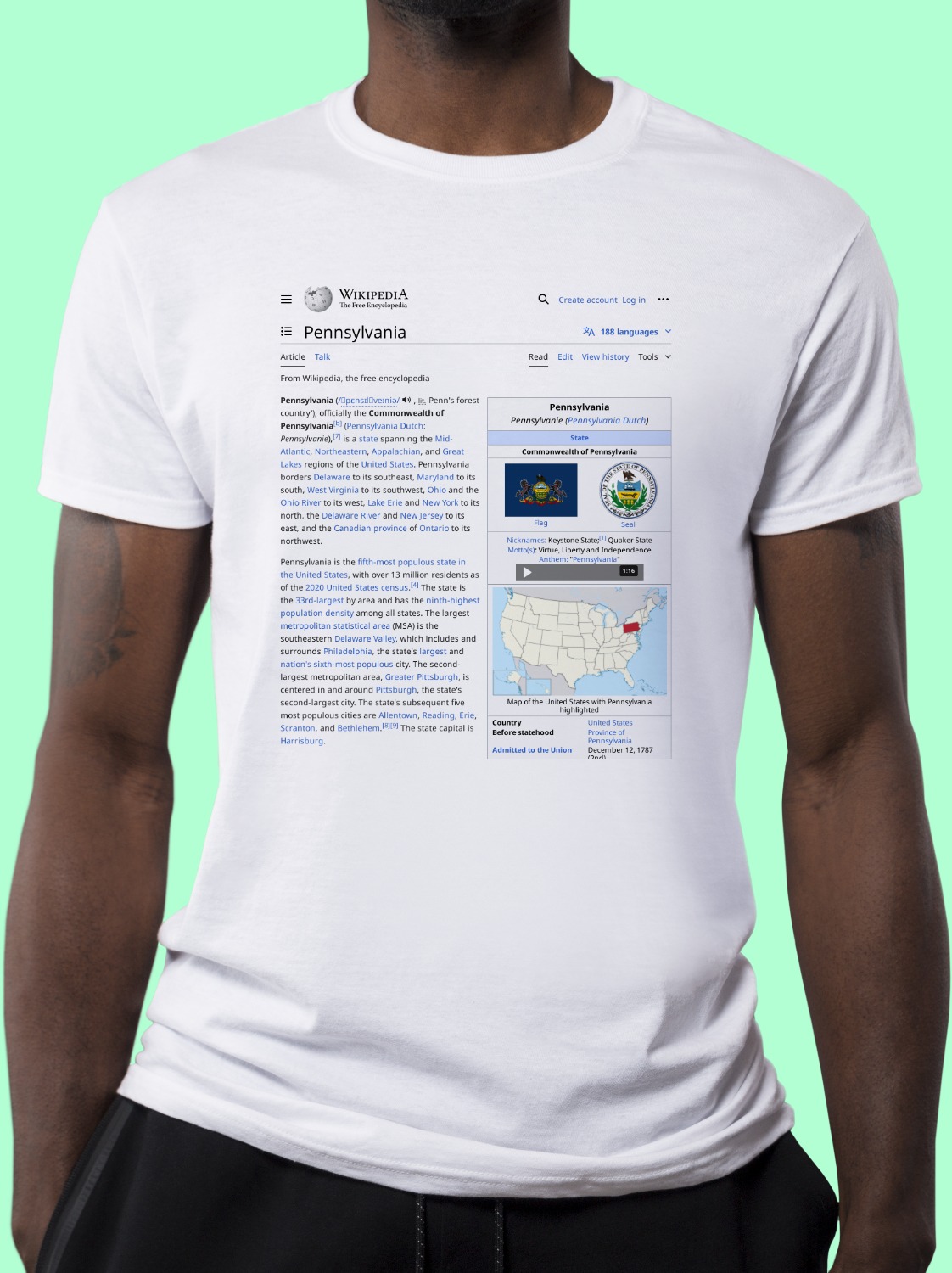
Pennsylvania Shirt
A classic cotton tee emblazoned with the Wikipedia article on Pennsylvania ↗.
cotton tee emblazoned with the Wikipedia article on Pennsylvania ↗.- Preshrunk jersey knit
- Seamless double-needle 2.2 cm collar
- Taped neck and shoulders
- Tear away label
- Double-needle sleeve and bottom hems
- Quarter-turned to eliminate centre crease
Pennsylvania, officially the Commonwealth of Pennsylvania, is a state spanning the Mid-Atlantic, Northeastern, Appalachian, and Great Lakes regions of the United States. It borders Delaware to its southeast, Maryland to its south, West Virginia to its southwest, Ohio and the Ohio River to its west, the Canadian province of Ontario to its northwest via Lake Erie, New York to its north, and the Delaware River and New Jersey to its east. Pennsylvania's most populous city is Philadelphia. The state capital is Harrisburg. Among all states, Pennsylvania is the fifth-most populous with over 13 million residents as of the 2020 United States census, the ninth-highest by population density, and the 33rd-largest by land area. The largest metropolitan statistical area is the southeastern Philadelphia metropolitan area, centered on Philadelphia, the state's most populous and nation's sixth-most populous city. The second-largest metropolitan area, Greater Pittsburgh, is centered in and around Pittsburgh, the state's second-largest city.
Pennsylvania was founded in 1681 through a royal land grant to William Penn, the son of the state's namesake. Before that, between 1638 and 1655, a southeast portion of the state was part of New Sweden, a Swedish colony. Established as a haven for religious and political tolerance, the colonial-era Province of Pennsylvania was known for its relatively peaceful relations with native tribes, innovative government system, and religious pluralism. Pennsylvania played a vital and historic role in the American Revolution and the ultimately successful quest for independence from the British Empire, hosting the First and Second Continental Congress in Philadelphia, the latter of which formed the Continental Army commanded by George Washington in 1775, during the American Revolutionary War, unanimously adopted the Declaration of Independence the following year. On December 12, 1787, Pennsylvania was the second state to ratify the U.S. Constitution, right after Delaware.
The Battle of Gettysburg, fought in July 1863 around Gettysburg, was the bloodiest battle of the American Civil War with over 51,000 Union and Confederate casualties, and resulted in a repulsion of the Confederacy's invasion of the North. Throughout the late 19th and 20th centuries, the state's steel production and manufacturing-based economy contributed to the development of much of the nation's early infrastructure, including key bridges, skyscrapers, and military hardware used in U.S.-led victories in World War I, World War II, and the Cold War.
Pennsylvania's geography is highly diverse. The Appalachian Mountains run through the center of the state, the Allegheny and Pocono mountains span much of Northeastern Pennsylvania, and close to 60% of the state is forested. Although it has no ocean shoreline, it has 140 miles (225 km) of waterfront along Lake Erie and the tidal Delaware River.
About Wikishirt
Wikishirt is a retail experiment that lets you buy a shirt with any Wikipedia Article printed on it. There are over 5 million Wikipedia articles, so we have over 5 million shirts.Check out our homepage for random featured shirts and more!